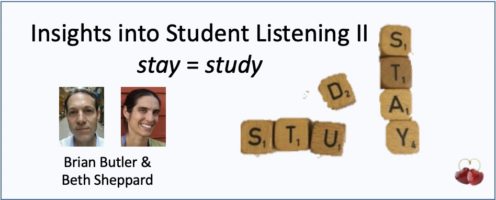48 – Insights into Student Listening: study = stay
This is the second of three posts inspired by Beth Sheppard and Brian Butler’s wonderful paper ‘Insights into Student Listening … ‘ (Sheppard & Butler, 2017). It is a research paper, but it clearly demonstrates the value of an activity which – in my view – ought to be an essential component of every listening comprehension class.
This activity is the paused dictation (Field, 2008). In this post we will look at and (most importantly) listen to what some of Beth and Brian’s students made of the word study in the four-word phrase study that was done. The two syllables of study were transcribed by four students as a single syllable stay; six other students had monosyllabic transcriptions (stay, stayed, stains, still, stand, state) and sixteen did not transcribe it at all. (A total of 77 students were involved).
This is the recorded extract of the four-word phrase study that was done:
To my ears, on first hearing, the soundshape of study is clearly two syllables – all segments of the citation form are present |stʌd.i|. So why would students hear it as stay? Maybe their perception dropped momentarily in the middle of the word, maybe they are good at hearing beginnings and ends of words, but not the middles. Maybe, in other words, it is their fault that they do not hear the full word. And anyway, the word stay does not fit the contextual meaning – how could they be so stupid!??
They are not stupid at all. For two reasons: first, in doing such decoding exercises students very commonly work by setting considerations of meaning to one side, and wrestle with the sound substance in a meaning vacuum; second, the representation of the soundshape of study as stay turns out to be accurate.
Don’t believe me? Listen to the soundshape of study on its own:
Oh dear. Now that the word study is isolated like this, to my ears it has become a monosyllabic-like |stʌi| with the consonant |d| dropped. So give credit to those students who wrote monosyllabic representations of the soundshape as stay – they have succeeded in hearing the soundshape for what it is.
It happens not to match the speaker’s intended word, but it is a more accurate representation of the soundshape than the orthodox spelling study and its citation form soundshape |stʌd.i|.
Theirs is a perfectly reasonable hearing. So, learners have had more success than the expert listener in perceiving and reporting on what the sound substance contains. And this is such an important point, of which I write fairly extensively in A Syllabus for Listening – Decoding (Cauldwell, 2018, Chapter 4).
Expert listeners suffer from the blur-gap
We therefore need to respect the students’ perceptions, and work with perceptions such as these: our students may not understand what they are listening to, but they may be hearing the sound substance better than expert listeners do! And their perceptions can guide us blur-gapped teachers and authors to a true appreciation of the nature of the sound substance of speech.
By the way, the streamlining process which changes study into stay is a type of consonant death I term d-drop (cf. Cauldwell, 2018, Chapter 17) and it is not a rare occurrence.
Cauldwell, R.T. (2018). A Syllabus for Listening – Decoding. Birmingham: Speech in Action.
Field, J. (2008). Listening in the Language Classroom. Cambridge: Cambridge University Press.
Sheppard, B. & Butler, B. (2017). Insights into student listening from paused transcription. CATESOL Journal, 29.2, 81-107


